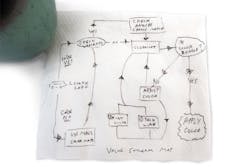Performance is everything in today’s collision repair industry.
Customers want their cars back quicker so they can hit the road, insurance companies want to please those customers and save as much as possible in the process, and shops want to partner with those insurance companies to bring in more customers. It all comes down to cycle time.
“Maybe a few DRPs are made with a handshake, but not so much anymore,” says Tony Adams, owner of Weaver’s Auto Center in Kansas City. “These days, the emphasis is more and more on how well you perform.”
To stay afloat in this competitive market, Adams’ shop did what many others have done in recent years—it took a good, hard look at its cycle time through a process called value stream mapping. It’s not a new strategy, but the demand for it has grown, says Mark Mueller, senior manager of business solutions for PPG.
Mueller says PPG has created value stream maps, which identify wasted and necessary time in each step of the repair process, for more than 100 shops during the last three years. PPG is one of several companies that offer the service; most of the major paint companies provide it in some form.
Adams says the process uncovered numerous inefficiencies at his shop. During estimates, for example, estimators would take notes on a notepad and later transfer those notes to a computer. Adams eliminated that step by providing estimators with laptops.
He says insurers in his area are more concerned about increasing touch time, which is the amount of time repairers actually spend working on a vehicle while it’s at the shop. He says lower cycle time actually leads to higher touch time, because the time a vehicle sits idle is reduced. His shop’s touch time has increased from 2.4 hours per vehicle per day to 2.7 hours per vehicle since developing a value stream map a year ago. His goal is to get touch time up to 3.5 hours per vehicle.
The improved efficiency should please customers and insurers, increase capacity and help to strengthen or add DRP relationships, Adams says.
George Avery, a claims consultant for State Farm, says cycle time factors into his company’s three-tiered performance report card for shops, which evaluates quality, efficiency and competitive price.
As with most insurance companies, State Farm doesn’t have a set requirement for cycle time, but it recognizes its importance, he says.
The company recently estimated that if all of its partner shops cut cycle time by one day, it could save more than $40 million in rental fees alone. It’s a lot of money, Avery says, but the goal is simply to increase efficiency, which is in the customer’s best interest.
“There is proof that not only is State Farm interested in cycle time going down, but we’re trying to take steps to help,” Avery says.
The company recently announced plans to develop a new electronic parts ordering solution to speed the repair process. It plans to work with repairers, parts suppliers and tech vendors on the program.
“We know a well-designed parts ordering solution will help reduce the amount of time needed to search for, source and order all part types,” said Greg McDonald, a claims estimating consultant for State Farm, in a video about the ordering solution sent to repairers.
The need for reduced cycle time is probably only going to intensify in coming years and tools such as value stream mapping will continue to gain momentum as a result, says Mueller. Not every shop needs to develop a detailed map of its process, he says, but each facility should be thinking about how it can perform better.
“Some customers would be out of business today if they hadn’t done this,” he says.
